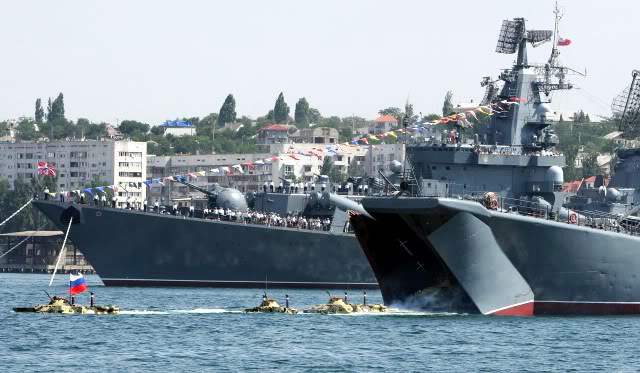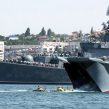
Moscow Begins Building a New Black Sea Fleet
Publication: Eurasia Daily Monitor Volume: 11 Issue: 166
By:

After annexing Ukraine’s Crimean peninsula, Russia is now rebuilding its Black Sea Fleet (BSF) to ensure its regional dominance, to exclude all rivals, and to lay the foundation for further external power projection, threatening other littorals like Romania and Bulgaria.
In April 2014, Putin directed the government and defense ministry to formulate a development program for the BSF (RIA Novosti, April 9). Simultaneously, defense analysts suggested deploying bombers in Crimea and to intensify active monitoring of the United States’ and the North Atlantic Treaty Organization’s (NATO) regional naval operations. In particular, they alleged that US destroyers were a direct threat to the functioning of Russian’s strategic nuclear forces (RT, July 7; RIA Novsoti, May 28). Russian military flights occur regularly as NATO conducts local exercises and monitors the Black Sea situation. Indeed, the August 2014 appearance of the USS Vella Gulf missile cruiser in the Black Sea compelled Moscow to ask Ankara to close the Turkish Straits to non–Black Sea states (RT, novinite.com, RIA Novosti, August 7).
Clearly, Moscow is building a classic Russian combined-arms air and naval defense network in Crimea to threaten and interdict foreign fleets in the Black Sea. As Russia has been expanding its strategic aviation patrol routes above the Black Sea, its Su-24 fighters practice strikes against “imaginary detachments” of enemy warships together with “surface strike groups and shore-based naval missile units” (RIA Novosti, May 6). Moreover, Defense Minister Sergei Shoigu announced that Russia would spend $2.4 billion by 2020, to provide the BSF with next-generation warships and submarines, air defense systems, and marine (“naval infantry,” in Russian) regiments in 2014–2015 (Interfax, May 6). This past July, BSF commander Admiral Alexander Vitko told his forces, “Today, we have started forming a powerful Black Sea Fleet with an absolutely different level of air service, coastal missiles and artillery troops and marines” (PressTV, July 23). Other sources say Moscow may rebuild its missile early-warning station in Crimea as well. These new forces comprise a costal defense brigade, an artillery regiment, new naval aviation aircraft, and reinforcement of its air defense command and reconnaissance units (Interfax, July 28).
Similarly, Rear Admiral Anatoly Dolgov, the head of the Southern Military District Staff’s naval department, cited an increased development program of 90 billion rubles (approximately $2.75 billion) until 2020 to deploy new naval and coastal units in Crimea and restore formerly reduced ones. All told, about 30 new ships will be added to the BSF and the attached Mediterranean Task Force, including six new frigates, six new submarines, the Mistral amphibious assault ship and helicopter carrier, and other smaller vessels (Eurasia Insight, April 27). As previously reported, Moscow will also deploy modernized Su-27SM and MiG-29 fighters; Su-25M ground attack aircraft; Il-38N anti-submarine warfare (ASW) aircraft; Ka-27 ASW helicopters; Ka-52K attack helicopters; and the new Su-30M naval aviation fighters. Also, by 2016, a regiment of TU-22M3 long-range bombers will deploy at the Gvardeyskoye airfield (about 15 kilometers northwest of Simferopol). These aircraft are platforms for supersonic, long-range, anti-ship cruise missiles to support the Mediterranean Task Force and establish an added “deterrence potential” in Southern Europe, the Middle East and North Africa. Additionally, ground forces will be reconstituted, redesigned and given long-range, mobile Bastion-P systems armed with Oniks supersonic, anti-ship cruise missiles for the seaward defense of Crimea. Moscow claims the Oniks are impervious to all modern air defense systems (Vzglyad, May 5).
If Moscow can add its new Rapid Reaction forces, which include airborne and Special Operations Forces (SSO), to the accumulating military presence in Crimea, it will have a formidable strike force covering the entire Black Sea zone. In 2013, these troops and the naval infantry (the forces that led the Crimean invasion) practiced tasks in coordination with large landing ships of the Russian navy (evidently implying amphibious operations—see Pauli Jarvenpaa, Zapad-2013: A View From Helsinki, August 2014). The Mistral-class amphibious assault/helicopter carrier is thus vital to Russian plans in the Black Sea and other theaters. Russian military literature and exercises place heavy emphasis on amphibious landing and counter-landing operations. And the Mistral provides Moscow with just such capabilities.
With the Mistral, Moscow could conduct an unimpeded heliborne assault over the cliffs of the Black Sea and Sea of Azov coasts in southeastern Ukraine and oust the Ukrainian ground forces from that vital area. Russia has launched several probes from Crimea into Ukraine and apparently laid mines in the Sea of Azov to interdict Ukrainian or other navies (Interfax-Ukriane, July 21). Therefore, the Mistral would be an invaluable combat and command-control-communications-intelligence (C3I) asset in amphibious landing operations in the Baltic or in the Black Sea against Ukraine, Georgia or the Balkans.
Swedish security analyst Bo Pelinas commented that in the Zapad 2009 exercises, Russian forces conducted landings on an open coast, highlighting the value the Mistral would bring (SvD Online, December 1, 2009). The ship also could serve as a powerful platform for ASW helicopters to operate in the Baltic or Black Seas. Given Moscow’s takeover of Crimean energy installations and fields, Moscow is likely to place anti-submarine sensors on the peninsula to protect energy installations as part of an ASW network—as it has done in the Baltic (SRI International, January 5, 2010; Geopolitical Information Service, February 24, March 18).
Russian military drills in the Baltic have focused on deterring hostile attacks on its natural gas infrastructure such as Nord Stream. Russia’s Navy announced that it will deploy, if necessary, to defend against terrorist attacks in the Baltic (Barents Observer, August 21, 2009). Therefore, similar ASW exercises and deployments are likely in the Black Sea, too. Finally, the Mistral could be useful in Noncombat Evacuation Operations (NEO) or as manifestations of Russian gunboat diplomacy, many examples of which have already been seen in Syria and Cyprus (see EDM, July 17, 2013; Cyprus Mail, October 2, 2011; asianews.it, October 5, 2011; Interfax, May 7, 2012).
Despite serious problems afflicting its naval procurement, Russia is proceeding to develop capabilities to sequester the Baltic and the Black Seas behind its air, naval, cyber and nuclear defenses. Moscow aims to deter enemies from entering those seas to defend themselves against the offensive capabilities that Russia is developing. Such military intimidation of local states and deterrence of NATO are part of Russia’s overall political strategy to revise the European status quo and neutralize the other post-Soviet states’ effective sovereignty. And if Moscow does, indeed, launch another invasion of Ukraine disguised as a “humanitarian intervention,” the naval dimension could well come into play.




